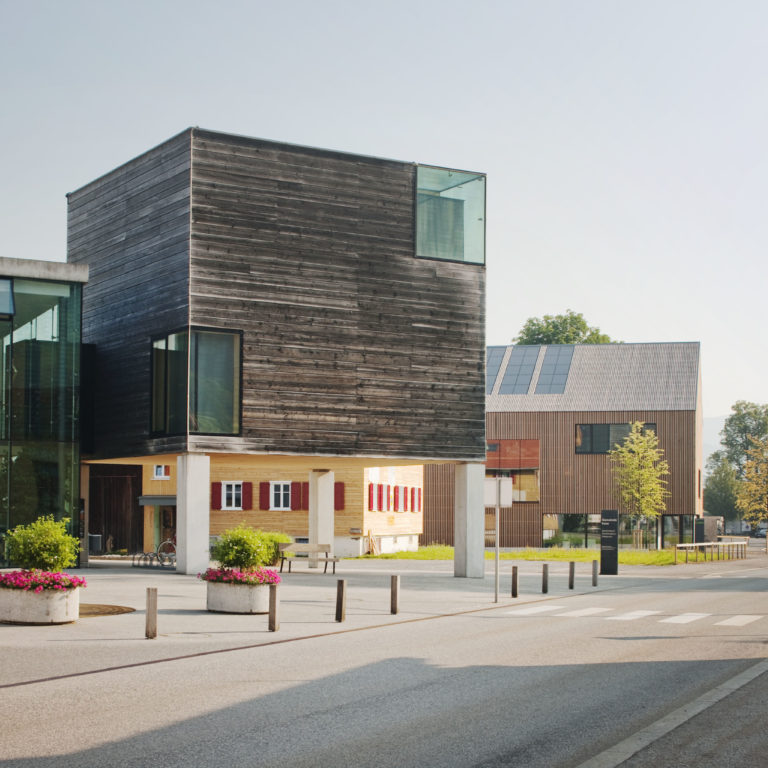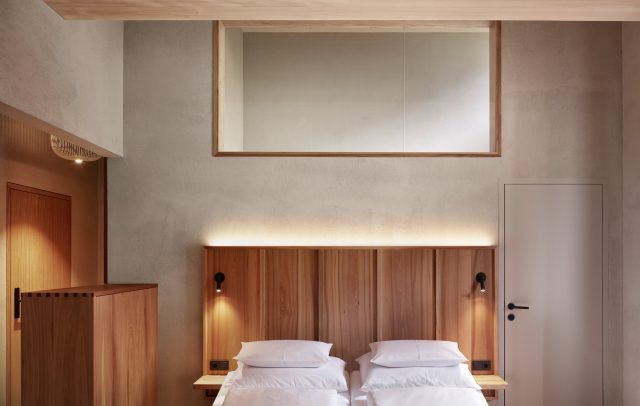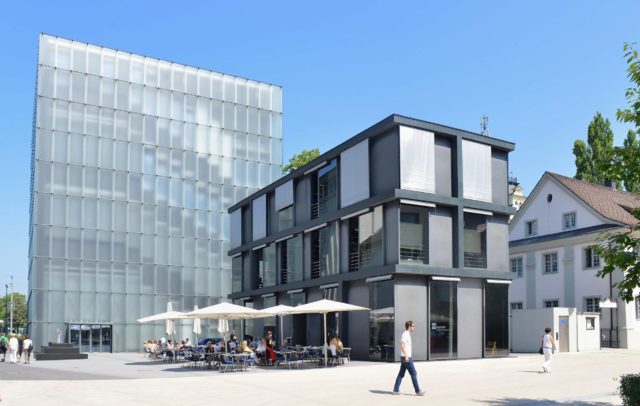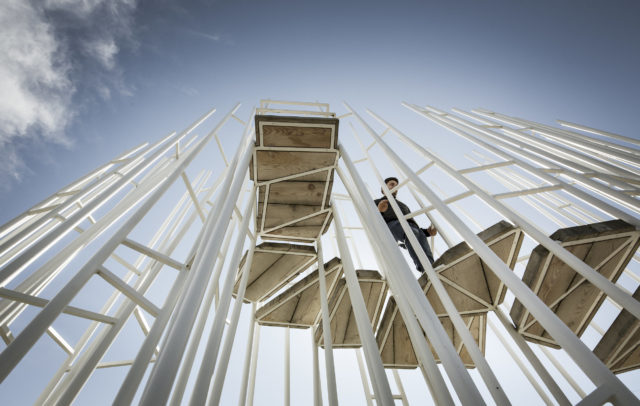

C Dorfzentrum Andelsbuch, (c) Albrecht Immanuel Schnabel
Land of Building Culture
Architecture Trails
Vorarlberg, Austria's westernmost province, has garnered international reputation for its wealth of high-quality architecture. Modern building materials, openness, the skillful use of indigenous timber and, above all, as sure instinct of architects and builder-owners for the surroundings have added new qualities to the image of Vorarlberg.
For decades, Vorarlberg has been a trailblazer when it comes to architecture and crafts. Seven differently-themed architectours take visitors with an interest in architecture and design to hand-picked contemporary and traditional buildings.
Vorarlberg’s contemporary architecture has its roots in the 1960s, when a group of fledgling architects who wanted to break new ground formed. Calling themselves the “Vorarlberg Design Artists”, they cultivated an absolutely novel style, both in terms of architecture and the way they cooperated with building authorities and builder owners. Their idea of architecture revolved around notions such as clear lines, minimalist forms, a sparing use of natural resources, blending in harmoniously with the surroundings, and – above all – affordability. This new thinking soon caught on and attracted international attentiion.
Today, virtually all municipal buildings and many private homes as well as reconstructions and adaptations of traditional buildings in Vorarlberg are architect-designed. Indigenous timber has been the building material of choice since time immemorial. Energy-efficient design is common standard. In this respect as well, Vorarlberg´s architects are genuine pioneers.
Architecture Trails
Compiled by the Vorarlberger Architektur Institut and the Vorarlberg Tourist Board 7 tours shed light on the regional architecture. They inspire visitors to devote themselves to one theme. The themes on offer include “New impressions”, “Art and culture”, “Timber and loam”, “Old and new”, “Revitalised villages” and “Architecture and landscape”, “Craft and innovation”. The non-guided tours take visitors to urban and rural regions, allow for plenty of time to take a walk, visit a museum or other public buildings and for culinary breaks.
-
New impressions
... a tour of Vorarlberg’s cities.
The Rheintal valley in Vorarlberg has…
-
43.98 km
-
6 h
-
leicht
Difficulty: leicht Distance: 43.98 km Ascent: 390 m Descent: 344 m Duration: 6 h Deepest point: 398 m Highest point: 616 m Experience: Landscape: New impressions
... a tour of Vorarlberg’s cities.
The Rheintal valley in Vorarlberg has developed…
Start of tourBregenz
End of tourFeldkirch
Description… a tour of Vorarlberg’s cities.
The Rheintal valley in Vorarlberg has developed into a cohesive settlement boasting a unique urbanity that unites city and country. Here, internal borders become blurred and small-scale structures are infused with urban charm. The cities of Vorarlberg have evolved considerably in recent decades, with former industrial areas now given over to cultural, office and residential buildings. Historic local centres are also enjoying a…
Best season
All route infoJAN FEB MAR APR MAY JUN JUL AUG SEP OCT NOV DEC -
-
Art and culture
... from Bregenz to Feldkirch.
Vorarlberg’s diverse cultural landscape has been bolstered by the…
-
40.21 km
-
6 h
-
leicht
Difficulty: leicht Distance: 40.21 km Ascent: 159 m Descent: 83 m Duration: 6 h Deepest point: 397 m Highest point: 477 m Experience: Landscape: Art and culture
... from Bregenz to Feldkirch.
Vorarlberg’s diverse cultural landscape has been bolstered by the construction…
Start of tourBregenz
End of tourFeldkirch
DescriptionThe cultural buildings of Vorarlberg are testament to the historic depth of this region, which has been returned to the limelight by a series of dedicated individuals – and not always without controversy. Vorarlberg’s complex settlement history and constant migration flows have made a sizeable impression on local culture that continues to this day, including aspects such as Roman excavations, a substantial legacy of farming and craftsmanship, and a lasting,…
Best season
All route infoJAN FEB MAR APR MAY JUN JUL AUG SEP OCT NOV DEC -
-
Timber and loam
... from the Rheintal valley and Walgau to the Grosses Walsertal valley.
In Vorarlberg,…
-
47.46 km
-
6 h
-
leicht
Difficulty: leicht Distance: 47.46 km Ascent: 1116 m Descent: 1031 m Duration: 6 h Deepest point: 466 m Highest point: 986 m Experience: Landscape: Timber and loam
... from the Rheintal valley and Walgau to the Grosses Walsertal valley.
In Vorarlberg, timber…
Start of tourKlaus
End of tourLudesch
DescriptionVorarlberg’s commitment to contemporary architecture has had a number of positive effects, breathing new life into craftsmanship and timber construction in particular. Planners boasting high standards and technical expertise have combined with an innovative craft culture to boost the quality of details and materials alike, gradually inspiring the spread of the now-popular aesthetic featuring clear structures, subtle forms and untreated material surfaces. In blending the old and the new, it…
Best season
All route infoJAN FEB MAR APR MAY JUN JUL AUG SEP OCT NOV DEC -
-
Old and new
... in the Rheintal and Walgau valleys.
The interplay of old and new architecture…
-
48.17 km
-
6 h
-
leicht
Difficulty: leicht Distance: 48.17 km Ascent: 302 m Descent: 209 m Duration: 6 h Deepest point: 403 m Highest point: 564 m Experience: Landscape: Old and new
... in the Rheintal and Walgau valleys.
The interplay of old and new architecture enjoys…
Start of tourDornbirn
End of tourNenzing
DescriptionThis appreciation of anonymous construction and a rustic, rural building culture was readily apparent in the first generation of Vorarlberg’s architecture movement. In the mid 1970s, a group of forward thinkers including highly ambitious architects and building owners overcame significant opposition in order to preserve historic structures. Rather than being limited to formal imitation, their interest in this architectural legacy was always focused on the building structure, materiality and knowledge…
Best season
All route infoJAN FEB MAR APR MAY JUN JUL AUG SEP OCT NOV DEC -
-
Revitalised villages
... from Lochau and Wolfurt to the Bregenzerwald.
Vorarlberg is remarkably densely populated, yet…
-
62.09 km
-
6 h
-
leicht
Difficulty: leicht Distance: 62.09 km Ascent: 1508 m Descent: 1286 m Duration: 6 h Deepest point: 398 m Highest point: 810 m Experience: Landscape: Revitalised villages
... from Lochau and Wolfurt to the Bregenzerwald.
Vorarlberg is remarkably densely populated, yet often…
Start of tourLochau
End of tourSchwarzenberg
DescriptionContemporary architecture in rural regions is usually limited to individual structures, and Vorarlberg was long part of this trend. But in the 1990s, Vorarlberg witnessed the rise of a competition culture for public buildings that increasingly integrated village centres and surrounding areas into the designs. Thanks to this growing focus on contemporary buildings, a number of village centres now boast a wonderful portfolio of high-quality architecture.
Maintaining decentralised operations…
Best season
All route infoJAN FEB MAR APR MAY JUN JUL AUG SEP OCT NOV DEC -
-
Architecture and landscape
... from Lake Constance to Montafon.
“Building in context” has been one of…
-
80.35 km
-
6 h
-
leicht
Difficulty: leicht Distance: 80.35 km Ascent: 655 m Descent: 395 m Duration: 6 h Deepest point: 398 m Highest point: 681 m Experience: Landscape: Architecture and landscape
... from Lake Constance to Montafon.
“Building in context” has been one of the…
Start of tourLochau
End of tourTschagguns/Vandans
DescriptionThis tour takes in a number of destinations where the landscape and the structures exist in perfect harmony. Where the harbour building “Die Welle” (“The Wave”) pays tribute to Lake Constance through its name and its curved design, the subtly crafted driving range at the golf course in Rankweil blends in seamlessly with its surroundings and Schruns’ Alpin Sport Zentrum features a raw natural facade that wonderfully complements the mountain…
Best season
All route infoJAN FEB MAR APR MAY JUN JUL AUG SEP OCT NOV DEC -
-
Craft and innovation
... in the Bregenzerwald region.
Quality craftsmanship is a key prerequisite for quality architecture…
-
38.74 km
-
6 h
-
leicht
Difficulty: leicht Distance: 38.74 km Ascent: 2785 m Descent: 2785 m Duration: 6 h Deepest point: 490 m Highest point: 828 m Experience: Landscape: Craft and innovation
... in the Bregenzerwald region.
Quality craftsmanship is a key prerequisite for quality architecture in…
Start of tourRiefensberg
End of tourBezau
DescriptionCraftsmanship is one of the foundational elements of Vorarlberg building culture. Following decades of efforts to nurture cooperation and mutual understanding, the attention to detail and planning that cater to the needs of craftsmanship have served as key criteria for a number of successful architecture projects. The conscious selection of structural and visual materials has even become the basis for a new expression of architecture and aesthetics, with clarity and…
Best season
All route infoJAN FEB MAR APR MAY JUN JUL AUG SEP OCT NOV DEC -

















































